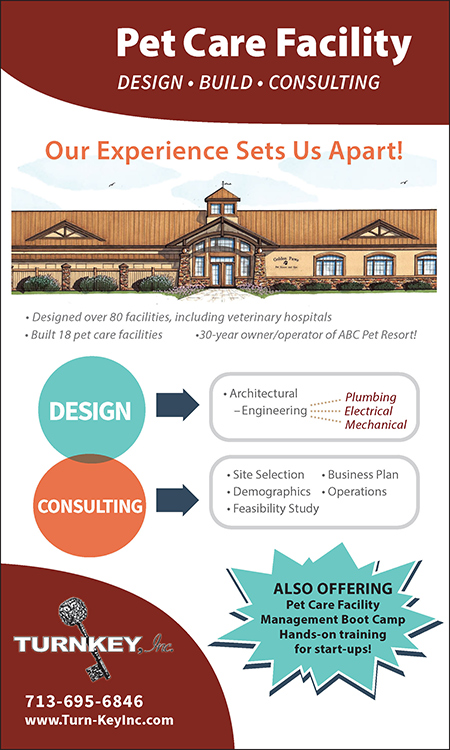
By Madison Warner
 he core ideal of many pet businesses is the health and happiness of the animals they serve, but sometimes businesses take a compartmentalized approach by only focusing on one part of the animal. Working with happy, healthy pets can ease strain on your staff and reduce the risk of a problem occurring in your business. Happy, healthy pets also create life-long customers and boost your business’s bottom line. Below is an outline on pet wellness and how to integrate it in your business.
he core ideal of many pet businesses is the health and happiness of the animals they serve, but sometimes businesses take a compartmentalized approach by only focusing on one part of the animal. Working with happy, healthy pets can ease strain on your staff and reduce the risk of a problem occurring in your business. Happy, healthy pets also create life-long customers and boost your business’s bottom line. Below is an outline on pet wellness and how to integrate it in your business.
To improve the quality of mental engagement for your clients’ pets, your business should assess your current services to see where you could add small (or big) changes to provide more stimulation. Here are some ideas of services to add if you’re currently only offering standard overnight boarding:
- Daycare and Training
- Fun daily activities to your existing services (puzzle toy, short walk, etc.)
- One-on-one “snuggle time” with a staff member
- Puppy preschool for guided socializing of puppies under one year old
- Novel or rotating group classes (scent work, agility, out & about, etc.)
- “Doggy & me” events where pups and their owners can socialize or interact together at your facility (doggy yoga, open houses, contests, 5Ks, etc.)
- Cat enrichment like nature TV, outdoor viewpoints, interactive toys, etc.

- Structured daycare programs that include quality play and rest times
- Walk or adventure add-ons
- Cozy bedding for pets who will not chew or ingest it
- Novel dog activities such as slat mill, agility or challenge course, weekly hiking
- A stretching, mobility or flexibility program
- Cat wheel, trees or tunnels for feline boarders to explore
- Hiding places for cats to nap in

Well-structured physical activity and mental engagement can fulfill pets’ needs within just a few minutes per day.
Groomers and veterinarians primarily take care of this part of a pet’s life, but all pet businesses can incorporate biological health services to promote overall wellness.

- Grooming or self-serve bathing
- Monthly or quarterly vaccination clinics hosted at your facility in partnership with a veterinarian
- A retail area offering pet food, treats and wellness items
- Partner with pet massage therapists, acupuncturists or other wellness providers to expand your service offerings
- Continuing health education for staff on recognizing pet health conditions
You might also consider areas where you could remove or adjust something within your business to improve pet wellness, such as:
- Sound dampening in drying rooms or dog lodging areas to reduce noise
- Separate entrances for daycare/training/grooming or for each species (cats-only entrance)
- Take extra measures to reduce overpowering smells in animal care areas
Charge Your Worth
Beyond this, any time you add quality to the service you are providing to your customers, you need to charge as such. To add a puzzle toy onto any service, it will take time to prepare, set the pet up with the toy, supervise and clean up afterwards, so you should charge a small fee. Not charging what your time and effort are worth brings the industry down as a whole.
While everything feels pricier these days, charging a fair price and compensating your staff well can help ensure longevity of your business. Remember that charging your worth is not about overpricing, but rather ensuring that your prices accurately reflect the value you provide to your clients and their pets. Novelty and scarcity also demand a higher price. Be transparent about your pricing, communicate the benefits of your services and maintain a commitment to excellence to justify your rates. Over time, as your reputation and client base grow, you’ll be better positioned to charge competitive and sustainable prices for your pet services.
Focusing on whole-pet wellness can make your business safer and more profitable by improving the health of your clients’ pets and reducing strain on your staff. Assess where in your business you could add or subtract services, operations techniques or functions to promote positive effects on the animals you work with.
By investing in their health through proper nutrition, regular exercise, mental stimulation, preventative care, and the love and attention they deserve, we can ensure our pets lead longer, happier lives. The journey to pet wellness is a rewarding one, filled with moments of laughter, play and companionship.
The information in this article is not a substitute for veterinary care or advice.
Madison Warner is owner of Ready Pet Education. She teaches pet first aid & other pet emergency education programs to pet professionals all over the United States. Ready Pet Education has been teaching veterinary supervised, comprehensive pet first aid courses since 2018, and offers online or in-person learning and bulk discounts for 15+ students. They also offer emergency and disaster preparedness consulting for all types of pet businesses! www.readypeteducation.com


